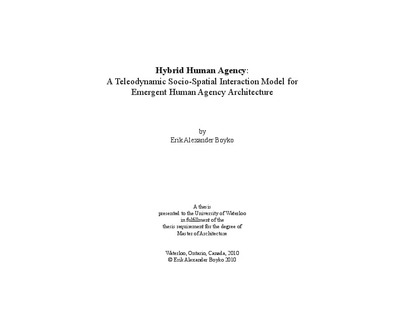| dc.contributor.author | Boyko, Erik | |
| dc.date.accessioned | 2010-04-22 18:25:04 (GMT) | |
| dc.date.available | 2010-04-22 18:25:04 (GMT) | |
| dc.date.issued | 2010-04-22T18:25:04Z | |
| dc.date.submitted | 2010-04-16 | |
| dc.identifier.uri | http://hdl.handle.net/10012/5082 | |
| dc.description.abstract | People relate with one another in space and through imagined and technologically mediated networks. This thesis is concerned with the relationship between these two types of social connections – spatial and network. Spatial connections structure collectives of people in the same place at the same time. Network connections structure relations between people without regard to place or time. Spatial connections are complex, but rigid by nature, while network connections are simple, but flexible. Essential articulations emerge between these two connection types. These articulations create and evolve contemporary socio-spatial systems such as the city, its many places, and groups of people therein. However, the basic human experience of these systems remains largely polarized between spatial and network social practices to the disadvantage of human agency.
This thesis proposes a teleodynamic, socio-spatial interaction model for the articulation of these social practices in human agency architecture. The model is a mobile experience design that functions through people with ‘smart’ mobile devices. It connects them with one another in public place and to global information and communication networks simultaneously. Sociological study informs the model’s design – constraints and conditions for the connection extents and integrity of social interaction. The model supports self-organizing circular relationships between human interaction dynamics and their trace structures based on a methodology for emergence in complex systems. It effects the emergence of the aforementioned socio-spatial, human agency architecture, with great flexibility. The model and architecture together serve to better articulate contemporary spatial and network social practices to the benefit of human agency in urban space. | en |
| dc.language.iso | en | en |
| dc.publisher | University of Waterloo | en |
| dc.subject | Socio-Spatial Interaction Model | en |
| dc.subject | Emergent Socio-Spatial Human Agency Architecture | en |
| dc.subject | Morphodynamics | en |
| dc.subject | Teleodynamics | en |
| dc.subject | Scale-Free | en |
| dc.subject | Small World | en |
| dc.subject | Ubiquitous Computing | en |
| dc.subject | Mobile Experience Design | en |
| dc.subject | Spatial Connection | en |
| dc.subject | Network Connection | en |
| dc.title | Hybrid Human Agency: A Teleodynamic Socio-Spatial Interaction Model for Emergent Human Agency Architecture | en |
| dc.type | Master Thesis | en |
| dc.pending | false | en |
| dc.subject.program | Architecture | en |
| uws-etd.degree.department | School of Architecture | en |
| uws-etd.degree | Master of Architecture | en |
| uws.typeOfResource | Text | en |
| uws.peerReviewStatus | Unreviewed | en |
| uws.scholarLevel | Graduate | en |

